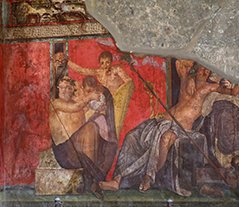 One of the most famous sites throughout Italy is Pompeii. Located in the Campania region under the majesty of Mount Vesuvius, it is one of those places that you must visit at least once in your lifetime to experience its magical atmosphere that will transport you backwards in time as you walk through its alleys and ruins.
One of the most famous sites throughout Italy is Pompeii. Located in the Campania region under the majesty of Mount Vesuvius, it is one of those places that you must visit at least once in your lifetime to experience its magical atmosphere that will transport you backwards in time as you walk through its alleys and ruins.
Just to refresh your mind, here is a brief summary of the story of Pompeii. In 79 AD, the thriving ancient Roman town of Pompeii was completely destroyed when nearby Mount Vesuvius erupted. The eruption itself spanned two days with ash and smoke emerging from Vesuvius throughout the morning of the first day. The volcano exploded in the afternoon, covering nearby settlements with ash, but most of Pompeii’s citizens remained in the city overnight ignorant of the catastrophe that was about to occur. It is uncertain whether the flows of lava began that night or early the next morning, but either way, once the lava began to flow into the city, the citizens were caught off guard and this resulted in the deaths of roughly 2,000 people. The entire town was buried under pumice and ash and lost for many centuries until being rediscovered at the very end of the 16th century. Most of the city’s artifacts were preserved extraordinarily well thanks to the reduced presence of moisture and air caused by the volcanic ash. As a result, Pompeii is perhaps the most well-preserved example of an ancient Roman city that can be visited today.
On December 24th, 2015, an important 3 million euro restoration project was completed in Pompeii and six new domus (houses) were opened to the public. These specific houses were chosen to be restored because they offer an amazing snapshot of what daily life in Pompeii was like shortly before the disastrous eruption of 79 AD. Some of the houses, like the Casa dell’Efebo, recount the lives of Pompeii’s richest citizens. Others, like the houses of Fabius Amandio and Sacerdos Amandus, are more modest and depict the lives of the common people. Though these houses are smaller and have fewer rooms, they were still decorated with an air of sophistication, which is quite noteworthy. The Cryptoporticus was also unveiled in December and this building is quite fascinating because its walls were decorated with high quality paintings depicting scenes from The Iliad.
A newly unveiled building of notable elegance is the house of Proculo, who was a rich baker. Both he and his wife are depicted in a painting that is considered to be one of the most important works of art ever produced in Campania and it is on display at the National Archeological Museum in Naples. Proculo’s house contains a mosaic floor unlike any other and walls painted with gorgeous Egyptian motifs, a style which was quite popular throughout ancient Rome at the time. The building is composed of three stories with a balcony on the first floor and it also features one of the most expansive and well-preserved atriums in all of Pompeii.
Another building of particular interest is the Fullonica di Stephanus, which is one of the most important and complete fabric manufacturing laboratories discovered in Pompeii. This sophisticated structure was equipped with large tubs for rinsing the fabric and with stone basins for dyeing, washing, and removing stains from the fabric. On the upper floor of the building there are large terraces where the cloth was dried and ironed with a press to give it a brilliant shine. The owner of the building was influential and prestigious and as a result the walls of the structure were decorated with magnificent paintings. Truly, each of these newly opened houses are meant to captivate visitors and help them experience a new side of Pompeii.
Clearly, Pompeii continues to amaze the hundreds of thousands of visitors it attracts each year. The town is a unique jewel worth admiring and ambitious restoration projects like the one completed in December ensure that Pompeii’s story will live on for centuries to come.
